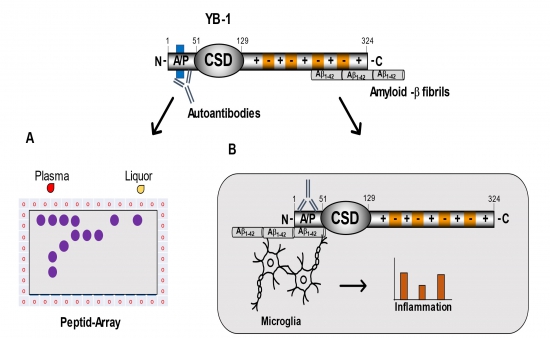Prof. Dr. Peter Mertens

Prof. Dr. Peter Mertens
Project Leader
Project 8
P8-1: DNA binding protein A is a key regulator of mitochondrial function that promotes renal ischemia/reperfusion injury
Charlotte ReichardtPhD Student
Peter MertensProject Leader |
Our previous data demonstrate that following acute kidney injury cold shock proteins Y-box binding protein-1 (YB-1) and DNA binding protein-A (DbpA) control cell recruitment to activated tubular cells and direct tubular cell phenotypes and survival. The function of YB-1 is highly context-specific, as mice with heterozygote YB-1 knockdown show diverse responses to injuries: following ischemia/reperfusion (I/R) the tubular damage is enhanced, whereas following tubular obstruction (UUO) damage is markedly reduced. Furthermore, we recently showed that high salt diet (HSD)-induced proximal tubular phenotypic activation and sodium-glucose cotransporter-2 expression are coordinated by YB-1. In addition, we identified Notch-3 as receptor for extracellular YB-1. In the absence of receptor Notch-3 tubular cells are unresponsive to cell stress and lack canonical NF-κB activation. Renal tubular epithelial cells are amongst the most metabolic active cells in humans with susceptibility to injuries (e.g. toxins, hypoxia) and orchestrate immune cell recruitment. If perpetuated, these processes lead to maladaptive responses, cell death and breakdown of the barrier functions in isolated nephrons. Tissue architecture devoid of tubular barrier function results in vascular rarefication and organ fibrosis. Collectively, cold shock proteins determine tubular cell fate decisions in an injury-specific manner. Elucidation of the underlying mechanism(s) during acute kidney injury is the focus of this project.
Tubular barrier system. The nephron is the smallest functional unit of the kidney and consists of a glomerular corpuscle and the tubular system. The tubular barrier is formed by epithelial cells and basement membranes and is supplied by adjunct blood vessels. In tubular epithelial cells DbpA is located at the cell membrane and upon tubular cell dedifferentiation may shuttle from the cytoplasm to the nucleus and coordinate proliferation. Furthermore, DbpA was detected as mitochondrial protein as it co-localizes with mitochondrial marker proteins. |
Photos: by UMMD, Melitta Schubert/Sarah Kossmann
P8-2: Determining the role of cold shock proteins on mitochondrial homeostasis and tubular cell phenotypes during cell stress
Sohail AhmadPhD Student
Peter MertensProject Leader |
Renal tubular epithelial cells are amongst the most metabolically active cells in the human body and are therefore highly susceptible to injury (e.g. toxins, hypoxia). If the insults are sustained, they can lead to maladaptive responses, including cell death and a subsequent loss of barrier function, which ultimately result in reduced kidney function.
|
Photos: by UMMD, Melitta Schubert/Sarah Kossmann
MD1: Depletion of DbpA (DNA binding protein-A) affects the inflammatory response and outcome of experimental kidney diseases
|
|
DbpA (DNA binding protein A) is a member of the human cold shock protein family. Cold shock proteins are characterized by the presence of one or more highly conserved cold shock domains, which possess nucleic acid binding properties. Thus, DbpA is a multifunctional RNA/DNA binding protein with pleiotropic functions, such as the regulation of cell proliferation, differentiation and stress responses. Evidence links a skewed cold shock protein expression pattern with inflammatory diseases and cancer. Upregulated DbpA expression has been observed in various types of cancer including hepatocellular carcinoma, gastric cancer, breast cancer, ovarian melanoma, colorectal cancer, and chronic myeloid leukemia. In healthy kidney tissue DbpA expression is found to be restricted to vascular smooth muscle cells but profoundly upregulated within the glomerular mesangial compartment in mesangioproliferative glomerularnephritis. This project aims to investigate the functional roles of DbpA in a murine model of mesangioproliferative glomerularnephritis, denoted nephrotoxic serum nephritis. Mice with genetic ablation of DbpA will be included into the study and compared to DbpA wildtype and DbpA heterozygous mice after disease induction. This will provide an insight into the disease-modulating effects of DbpA and its contribution to disease development and progression. Recent studies have shown modulating effects of DbpA concerning immune response. In order to determine immune cell infiltration, we will use flow cytometric analysis of kidney tissue. DbpA is further involved in cell-cell communication. Given its interaction with a major tight junction protein, Zonula occludens-1 (ZO-1), DbpA is denoted as ZO-1-associated nuclear acid binding protein (ZONAB) and is significantly involved in the regulation of podocyte interactions in the filtration barrier of the kidney. Malfunctioning podocyte interactions cause continuous leakage of plasma proteins (proteinuria) and is considered to be an important clinical risk factor in the progression of chronic kidney disease. Therefore we will further focus on alternations of podocyte interactions which depend on changes in the DbpA genotype and expression pattern in disease and health. The Podocyte Exact Morphology Procedure PEMP allows visualization of podocyte interactions along the filtration barrier, based on super-resolution microscopy. This method will be conducted in co-operation with the University of Greifswald. Further prospective cooperation partners are the Z-project SFB 854 for MELC analysis of DbpA and its interaction proteins and Project 9 of RTG 2408 for in vitro analysis of podocyte cell cultures. We hypothesize that DbpA is essential for the development of induced mesangioproliferative glomerular nephritis, while the expression level of DbpA influences the phenotype and the severity of the disease.
|
Photos: by UMMD, Melitta Schubert/Sarah Kossmann
MD5: Characterization of kidney organoids as a model system to analyze bacterial colonization
|
|
Organoids are three-dimensional cell cultures that resemble functional and structural traits of human organs. These structures have advantages over two-dimensional cell culture experiments given the establishment of complex polarized three dimensional cell-cell interactions that more closely mimic physiological barriers and functional processes in the human body. In our hands organoid structures develop following reprograming induced Pluripotent Stem Cells (iPSCs). Induced Pluripotent Stem Cells have been manipulated through retro- and lentiviral transduction of transcription factors such as Oct3/4, Sox2, Klf4, Lin28, Nanog and c-Myc causing them to regain their pluripotency when incubated with basic fibroblast growth factor (bFGF) and develop into kidney-like organoids following stimulation with a Wnt-agonist in 12 to 20 days. This project first aims to standardize the generation of kidney organoids. Kidney specific proteins and cell types are visualized and quantified by Western blotting, immunofluorescence staining and fluorescent activate single cell sorting. A comparison of different batches and different stages of organoid growth will be performed to assess variability in generating kidney organoids. High glucose and high salt addition to culture media and their influence on organoid generation are another focus of this project. Establishment of an infection model will be initiated after completion of standardization. For that means organoids of a chosen age will be incubated with bacteria such as Proteus mirabilis, Klebsiella pneumoniae, uropathogenic Escherichia coli tribes and Staphylococcus aureus, as the most common pathogens of acute infectious pyelonephritis. The bacterial colonization and infection will be monitored for bacterial numbers (multiplicity of infection) and spatiotemporal distribution throughout the organoid. Thus, novel insights into cellular responses following bacterial dissemination and cell damage as well as alterations in the barrier integrity will be gained. Furthermore, cell damage will be quantified by propidium iodine and annexin V staining as well as examination of damage and pathogen associated molecular patterns. Cooperation with other members of the RTG include Project 8, Prof. Dudeck’s, Prof. Naumann’s and Prof. Kahlfuß’ workgroup, as well as Prof. Kaasch and Prof. Zautner from the Institute of Microbiology.
Process of generating kidney organoids. After transforming adult somatic cells into iPSCs, these are held in culture on a basement membrane matrix. To set the conversion into kidney organoids in motion the iPSCs are stimulated for three days. Following that period, the organoid bodies will start to grow in size. On day 7 first tubular structures start appearing. Between day 12 and day 20 the differentiation of tubular segments reaches its peak and characterization as well as infection experiments are conducted in this time. From day 21 and onwards central fibrosis will arise due to deficient nutrient perfusion of the continuously growing organoid body. |
Photos: by UMMD, Melitta Schubert/Sarah Kossmann
MD10: Excessive sodium chloride ingestion promotes immune cell infiltration and kidney fibrosis in aging mice
|
|
Excessive sodium chloride ingestion is continuously rising in the western world. High salt diet (HSD) damages the kidneys leading to fibrosis, tubulointerstitial injury and renal hypertrophy. Furthermore HSD aggravates albuminuria and decreases the glomerular filtration rate, which is associated to a worse CKD prognosis. A focus of our group are the roles that cold shock proteins play in inflammatory diseases, with the most prominent being Y-box binding protein-1 (YB-1). Members of this protein family regulate cell proliferation, matrix synthesis and the inflammatory milieu. Within this project we plan to further investigate the role of YB-1 in an HSD-induced damage model. To achieve this we use an tamoxifen-inducible Ybx1 knockout (KO) strain and compare wildtype (WT) and KO mice that receive either a normal salt diet (NSD; standard chow, tap water) or a high salt diet (HSD; 4%NaCl in chow, 1% NaCl in water) for up to 16 months. So far it remains unclear whether a direct link between high salt intake and kidney fibrosis exists autonomously from arterial hypertension. Therefore our mouse model is remarkable as we could show the absence of elevated blood pressure in our animals. Our previous findings demonstrated that HSD-induced proximal tubular phenotypic changes and sodium-glucose cotransporter-2 expression are coordinated by cold shock Y-box binding protein-1 (YB-1). Furthermore we could show that HSD leads to kidney fibrosis and that this fibrosis is aggravated in YB-1 KO animals. To further determine the damage pattern of HSD-induced fibrosis we plan to perform immunohistochemical staining of kidney tissue for different markers of fibrosis. In addition we found that immune cell infiltration is increased under HSD while this immune response is blunted in YB-1 KO animals. To further understand the effect of excessive sodium intake on the immune system fluorescent activated single cell sorting of different infiltrating cells, that are influenced by HSD, will be performed.
|
Photos: by UMMD, Melitta Schubert/Sarah Kossmann
MD13: Deciphering extracellular cold shock protein: immunoglobulin G complex formation and elucidating cellular effects thereof
|
|
Cold shock proteins (CSPs) are among the most evolutionarily conserved protein families and are characterized by cold shock domains (CSDs) with highly conserved nucleic acid binding motifs. By interacting with single-stranded RNA and DNA, they regulate transcription, translation, and splicing, thereby influencing key processes such as cell proliferation. CSPs such as YB-1 and DbpA play central roles in stress responses and immune regulation acting extracellularly as alarmins, modulating immune activity, wound healing, and fibrogenesis. Our previous findings demonstrated that YB-1 and DbpA form high-molecular-weight complexes in serum and plasma, which co-migrate with immunoglobulin G (IgG). Depletion of IgG from human serum causes a marked reduction in CSP levels, confirming a physical interaction. This suggests the existence of protein complexes comprising IgG and CSPs, which can be selectively isolated from serum or plasma by IgG depletion. This project aims to investigate the cellular effects of native and reconstituted YB‑1/DbpA complexes. Using kidney cell models, we analyze how complex formation affects cytotoxicity, morphology, migration, and stress responses, including cytokine release. Patient studies will assess the abundance of YB-1/DbpA complexes in serum from individuals with systemic lupus erythematosus and cancer, and correlate levels with circulating DNA. Finally, uptake assays in monocytes will test whether these complexes facilitate DNA internalization and contribute to immune activation.
Panel A: Schematic representation of a reconstituted protein complex containing immunoglobulin G (IgG), cold shock proteins (YB-1 and DbpA), RNA, and divalent cations Panel B: Functional cell assays: Human kidney epithelial (HK2) cells are treated with reconstituted cold shock protein-IgG complexes to assess cytotoxicity (SYTOX and Annexin V assays), morphological changes (phase-contrast microscopy), cell migration (scratch assay), and stress or inflammatory signaling (cytokine and stress marker analysis). Panel C: Patient sample analysis: Native cold shock protein-IgG complexes are isolated from serum and plasma of healthy controls, patients with systemic lupus erythematosus, and patients with cancers of different origin using Protein A beads. Serum and plasma are analyzed by PicoGreen assay to quantify circulating cell-free DNA and by ELISA to measure YB-1/DbpA concentrations using a standard curve. |
Photos: by UMMD, Melitta Schubert/Sarah Kossmann
CS3: The role of the cold shock protein YB-1 and its autoantibodies in the disease process of Alzheimer's disease
|
|
The most common neurodegenerative disease-causing dementia is Alzheimer's disease. Current understanding of pathophysiology links progressive memory loss with neuronal cell death due to extracellular amyloid plaque formation and intracellular deposition of neurofibrillary tangles. Despite intensive research, the disease remains an enigma, although there is substantial evidence that both proinflammatory cytokines and autoantibodies not only play a minor role but can also be linked to causal factors. YB-1 is the prototypical member of cold shock proteins in humans and fulfills pleiotropic functions in the cell cycle, differentiation, stress response, DNA repair and inflammation response. In an Alzheimer's animal model, nasal immunization with YB-1 resulted in amyloid fibril destruction and cognitive improvement. Also, YB-1 could be linked within the process of senescence. In our own preliminary work, specific YB-1 autoantibody epitopes have already been disclosed in tumor patients. In addition, preliminary examinations in patients with Alzheimer's disease show another specific autoantibody epitope. The research project aims to investigate the hypothesis of whether the specific YB-1 autoantibody epitope (i) is established as a diagnostic marker in a large cohort of Alzheimer's patients or (ii) can be used as an early diagnostic marker (MCI, SCI), whether (iii) Autoantibodies play a role in the YB-1 biology and (iv) if they can influence the neuroinflammatory process. In this context, patients are recruited with the DZNE. Then experiments in protein biochemistry and cell culture are carried out. Plasma samples from Alzheimer's patients show a specific epitope in the N-terminal section of the cold shock protein YB-1. YB-1 interacts with amyloid-b fibrils. (A) The N-terminally located autoantibody epitope is mapped to the minimal binding sequence in the plasma and liquor of patients with Alzheimer's disease using an exceptionally fine peptide array. (B) That for the YB-1:b-amyloid interaction responsible YB-1 fragment should be determined using specific YB-1 protein deletion fragments. In addition, the interaction is examined in the presence of YB-1 antibodies and tested for inflammatory changes in the cell model.
|
Photos: by UMMD, Melitta Schubert/Sarah Kossmann



























